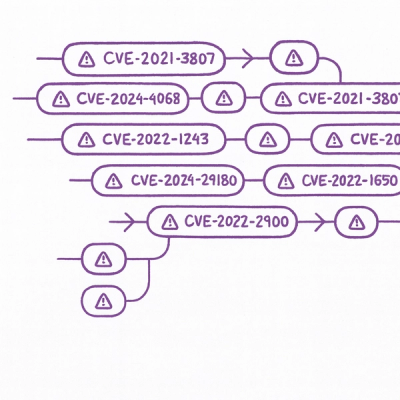
Security News
Astral Launches pyx: A Python-Native Package Registry
Astral unveils pyx, a Python-native package registry in beta, designed to speed installs, enhance security, and integrate deeply with uv.
google-oauth-gsi
Advanced tools
A user-friendly API for GIS SDK, using the new [**Google Identity Services SDK**](https://developers.google.com/identity/gsi/web) 🚀
Supply Chain Security
Vulnerability
Quality
Maintenance
License
A user-friendly API for GIS SDK, using the new Google Identity Services SDK 🚀
$ pnpm add google-oauth-gsi@latest
OAuth 2.0 implicit and authorization code flows for web apps
The Google Identity Services JavaScript library helps you to quickly and safely obtain access tokens necessary to call Google APIs. Your web application, complete either the OAuth 2.0 implicit flow, or to initiate the authorization code flow which then finishes on your backend platform.
Key Point: Add both
http://localhostandhttp://localhost:<port_number>to the Authorized JavaScript origins box for local tests or development.127.0.0.1is not a valid origin, uselocalhostinstead.
Configure your OAuth Consent Screen
Create instance of GoogleOAuthProvider somewhere in your application.
import { GoogleOAuthProvider } from 'google-oauth-gsi';
export const googleProvider = new GoogleOAuthProvider({
clientId: process.env.PUBLIC_GOOGLE_CLIENT_ID,
onScriptLoadError: () => console.log('onScriptLoadError'),
onScriptLoadSuccess: () => console.log('onScriptLoadSuccess'),
});
import { googleProvider } from './services';
const login = googleProvider.useGoogleLogin({
flow: 'auth-code',
onSuccess: (res) => console.log('Logged in with google', res),
onError: (err) => console.error('Failed to login with google', err),
});
// Call login() on button click
import { googleProvider } from './services';
const oneTap = googleProvider.useGoogleOneTapLogin({
cancel_on_tap_outside: true,
onSuccess: (res) => console.log('Logged in with google', res),
});
// Call oneTap() on onMount or onScriptLoadSuccess
or
import { buttonEl } from './somewhere';
import { googleProvider } from './services';
const renderButton = googleProvider.useRenderButton({
useOneTap: true,
element: buttonEl as HTMLElement,
onError: () => console.error('Failed to render button'),
onSuccess: (res) =>
console.log('Logged in with google (render button)', res),
});
// Call renderButton() onMount or onScriptLoadSuccess
If you are using one tap login, when logging user out consider this issue may happen, to prevent it call
googleLogoutwhen logging user out from your application.
import { googleLogout } from 'google-oauth-gsi';
googleLogout();
import { googleProvider } from './services';
const login = googleProvider.useGoogleLogin({
flow: 'implicit',
onSuccess: (tokenResponse) => console.log(tokenResponse),
});
// Call login() when you need
Requires backend to exchange code with access and refresh token. If you need
id_tokenthen use this. Check examples to see how to do it.
import { googleProvider } from './services';
const login = googleProvider.useGoogleLogin({
flow: 'auth-code',
onSuccess: (codeResponse) => console.log(codeResponse),
});
// Call login() when you need
import { hasGrantedAllScopesGoogle } from 'google-oauth-gsi';
const hasAccess = hasGrantedAllScopesGoogle(
tokenResponse,
'google-scope-1',
'google-scope-2',
);
import { hasGrantedAnyScopeGoogle } from 'google-oauth-gsi';
const hasAccess = hasGrantedAnyScopeGoogle(
tokenResponse,
'google-scope-1',
'google-scope-2',
);
| Required | Prop | Type | Description |
|---|---|---|---|
| ✓ | clientId | string | Google API client ID |
| onScriptLoadSuccess | function | Callback fires on load gsi script success | |
| onScriptLoadError | function | Callback fires on load gsi script failure |
| Required | Prop | Type | Description |
|---|---|---|---|
| flow | implicit | auth-code | Two flows, implicit and authorization code are discussed. Both return an access token suitable for use with Google APIs | |
| onSuccess | (response: TokenResponse|CodeResponse) => void | Callback fires with response (token | code) based on flow selected after successfully login | |
| onError | (errorResponse: {error: string; error_description?: string,error_uri?: string}) => void | Callback fires after login failure | |
| onNonOAuthError | (nonOAuthError: NonOAuthError) => void | Some non-OAuth errors, such as the popup window is failed to open or closed before an OAuth response is returned. popup_failed_to_open | popup_closed | unknown | |
| scope | string | A space-delimited list of scopes that are approved by the user | |
| enable_serial_consent | boolean | defaults to true. If set to false, more granular Google Account permissions will be disabled for clients created before 2019. No effect for newer clients, since more granular permissions is always enabled for them. | |
| hint | string | If your application knows which user should authorize the request, it can use this property to provide a hint to Google. The email address for the target user. For more information, see the login_hint field in the OpenID Connect docs | |
| hosted_domain | string | If your application knows the Workspace domain the user belongs to, use this to provide a hint to Google. For more information, see the hd field in the OpenID Connect docs |
| Required | Prop | Type | Description |
|---|---|---|---|
| prompt | '' | none | consent | select_account | defaults to 'select_account'. A space-delimited, case-sensitive list of prompts to present the user | |
| state | string | Not recommended. Specifies any string value that your application uses to maintain state between your authorization request and the authorization server's response |
| Required | Prop | Type | Description |
|---|---|---|---|
| ux_mode | popup | redirect | The UX mode to use for the authorization flow. By default, it will open the consent flow in a popup. Valid values are popup and redirect | |
| redirect_uri | string | Required for redirect UX. Determines where the API server redirects the user after the user completes the authorization flow The value must exactly match one of the authorized redirect URIs for the OAuth 2.0 client which you configured in the API Console and must conform to our Redirect URI validation rules. The property will be ignored by the popup UX | |
| state | string | Recommended for redirect UX. Specifies any string value that your application uses to maintain state between your authorization request and the authorization server's response | |
| select_account | boolean | defaults to 'false'. Boolean value to prompt the user to select an account |
| Required | Prop | Type | Description |
|---|---|---|---|
| ✓ | onSuccess | (response: CredentialResponse) => void | Callback fires with credential response after successfully login |
| onError | function | Callback fires after login failure | |
| promptMomentNotification | (notification: PromptMomentNotification) => void | PromptMomentNotification methods and description | |
| cancel_on_tap_outside | boolean | Controls whether to cancel the prompt if the user clicks outside of the prompt | |
| hosted_domain | string | If your application knows the Workspace domain the user belongs to, use this to provide a hint to Google. For more information, see the hd field in the OpenID Connect docs | |
| use_fedcm_for_prompt | boolean | Allow the browser to control user sign-in prompts and mediate the sign-in flow between your website and Google. Defaults to false. See Migrate to FedCM page for more information. |
| Required | Prop | Type | Description |
|---|---|---|---|
| ✓ | element | HTMLElement | The element to render the button in |
| ✓ | onSuccess | (response: CredentialResponse) => void | Callback fires with credential response after successfully login |
| onError | function | Callback fires after login failure | |
| type | standard | icon | Button type type | |
| theme | outline | filled_blue | filled_black | Button theme | |
| size | large | medium | small | Button size | |
| text | signin_with | signup_with | continue_with | signin | Button text. For example, "Sign in with Google", "Sign up with Google" or "Sign in" | |
| shape | rectangular | pill | circle | square | Button shape | |
| logo_alignment | left | center | Google logo alignment | |
| width | number | button width, in pixels | |
| locale | string | If set, then the button language is rendered | |
| useOneTap | boolean | Activate One-tap sign-up or not | |
| promptMomentNotification | (notification: PromptMomentNotification) => void | PromptMomentNotification methods and description | |
| cancel_on_tap_outside | boolean | Controls whether to cancel the prompt if the user clicks outside of the prompt | |
| auto_select | boolean | Enables automatic selection on Google One Tap | |
| ux_mode | popup | redirect | The Sign In With Google button UX flow | |
| login_uri | string | The URL of your login endpoint | |
| native_login_uri | string | The URL of your password credential handler endpoint | |
| native_callback | (response: { id: string; password: string }) => void | The JavaScript password credential handler function name | |
| prompt_parent_id | string | The DOM ID of the One Tap prompt container element | |
| nonce | string | A random string for ID tokens | |
| context | signin | signup | use | The title and words in the One Tap prompt | |
| state_cookie_domain | string | If you need to call One Tap in the parent domain and its subdomains, pass the parent domain to this attribute so that a single shared cookie is used | |
| allowed_parent_origin | string | string[] | The origins that are allowed to embed the intermediate iframe. One Tap will run in the intermediate iframe mode if this attribute presents | |
| intermediate_iframe_close_callback | function | Overrides the default intermediate iframe behavior when users manually close One Tap | |
| itp_support | boolean | Enables upgraded One Tap UX on ITP browsers | |
| hosted_domain | string | If your application knows the Workspace domain the user belongs to, use this to provide a hint to Google. For more information, see the hd field in the OpenID Connect docs | |
| click_listener | function | If set, this function will be called when the Sign in with Google button is clicked. | |
| use_fedcm_for_prompt | boolean | Allow the browser to control user sign-in prompts and mediate the sign-in flow between your website and Google. Defaults to false. See Migrate to FedCM page for more information. |
dev - starts dev serverbuild - generates the following bundles: CommonJS (.cjs) ESM (.mjs) and IIFE (.iife.js). The name of bundle is automatically taked from package.json name propertytest - starts jest and runs all teststest:coverage - starts jest and run all tests with code coverage reportlint:scripts - lint .ts files with eslintprepare - script for setting up husky pre-commit hookIf you want to make changes:
pnpm build && pnpm pack. This command will generate .tgz file in root directory..tgz file to your project and test changes. Run pnpm add ~/path-to-tgz-file.tgz to add package to your project.Commit with
pnpm commit!
Inspired by react-oauth
FAQs
A user-friendly API for GIS SDK, using the new [**Google Identity Services SDK**](https://developers.google.com/identity/gsi/web) 🚀
The npm package google-oauth-gsi receives a total of 1,276 weekly downloads. As such, google-oauth-gsi popularity was classified as popular.
We found that google-oauth-gsi demonstrated a not healthy version release cadence and project activity because the last version was released a year ago. It has 1 open source maintainer collaborating on the project.
Did you know?

Socket for GitHub automatically highlights issues in each pull request and monitors the health of all your open source dependencies. Discover the contents of your packages and block harmful activity before you install or update your dependencies.

Security News
Astral unveils pyx, a Python-native package registry in beta, designed to speed installs, enhance security, and integrate deeply with uv.

Security News
The Latio podcast explores how static and runtime reachability help teams prioritize exploitable vulnerabilities and streamline AppSec workflows.

Security News
The latest Opengrep releases add Apex scanning, precision rule tuning, and performance gains for open source static code analysis.